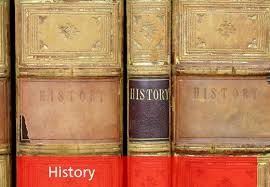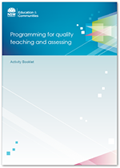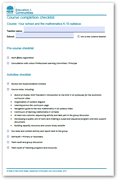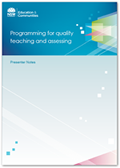Overview
Rationale/context |
|
|
Welcome to A process for programming a unit of learning: history K–10. This course focuses on the programming process specifically tailored to history. It is recommended that you refer to ONE syllabus topic throughout the course to support the development of the course deliverable–a unit of learning using Program Builder. Work your way across the tab headings above. Complete all activities before attempting the course deliverable. |
Copied under Pt VB Copyright Act 1969 |
This course has been designed with the assumption that you are familiar with the Board of Studies NSW History K–10 Syllabus.
You will need to have completed the Programming for quality teaching and assessing course (10 hours).
At the completion of this course, participants will:
-
be familiar with the Board of Studies NSW Syllabuses for the Australian Curriculum website, reflect upon the programming process for developing a unit of learning for the Board of Studies NSW History K–10 Syllabus
-
develop a unit of learning for the Board of Studies NSW History K–10 Syllabus
-
use the Board of Studies NSW Program Builder.
It is preferable to collaborate with a small team of colleagues when engaging with this course. A more experienced teacher or supervisor may lead a group of teachers through this course as a presenter. Presenter notes (.pdf 522kB) are available to assist.
If the opportunity for collaboration is not available, teachers may complete the course individually then confer with a supervisor to have their course completion verified on My PL@Edu.
|
Section |
Indicative time |
Description |
Deliverables |
|
Tab 1: Overview |
5 minutes |
Rationale/ Context Course pre-requisite Course objectives Course overview Before you begin Accreditation information |
|
|
Tab 2: Planning |
45 minutes |
Why plan? How to plan? What to plan? Scope and Sequence |
|
|
Tab 3: Programming |
120 minutes |
Overview Historical inquiry Historical concepts and skills Historical sources Using historical sites Learner diversity Learning across the curriculum Assessment |
|
|
Tab 4: Building your unit of learning |
120 minutes |
A process Program Builder Unit template |
Develop a unit of learning for history in Program Builder |
|
Tab 5: |
10 minutes |
Teachers will complete the deliverable for accreditation purposes. |
• complete the course checklist • submit the deliverable |
This course has been developed to cater for the diverse needs of teachers. Readings are recommended for participants to develop their knowledge and understanding of the planning and programming of History K–10 for quality teaching and learning. You may refer to:
-
Quality Teaching in NSW public schools (NSW Department of Education and Training, 2003)
-
Board of Studies NSW syllabuses.
Decide on one topic you would like to focus on throughout the course. Activities will ask you to refer to your chosen topic and each activity is directed at constructing different parts of a history unit of learning. The Activity booklet contains all the activities. Download the Activity booklet - PDF version (.pdf 656kB) or the Activity booklet - Word version (.docx 307kB) to record responses to each activity and use the information to build your unit in Program Builder.
Throughout this course you will find the following icons:
|
|
|
|
|
|
|
|
|
|
|
|
This DEC course (code 151ELP007) is registered professional development under the terms of the NSW Institute of Teachers Continuing Professional Development policy.
For teachers accredited at Professional Competence, completion of this course or program will contribute 5 hours towards Institute Registered professional development.
The following table details how the course, A process for programming a unit of learning: History K–10, addresses the Professional Teaching Standards.
|
Standard addressed by course |
Description of course content and how it addresses the Element and/or Standard |
|
2.2.2 Organise content into coherent, well sequenced learning and teaching programs |
Course participants:
|
|
3.2.2 Plan and implement well-structured learning and teaching programs or lesson sequences that engage students and promote learning |
Course participants:
|
|
6.2.2 Participate in learning to update knowledge and practice, targeted to professional needs and school and/or system priorities. |
Course participants:
|
The Department of Education and Communities is a NSW Institute of Teachers endorsed provider of professional development for the maintenance of accreditation at Proficient Teacher/Professional Competence.
Scope of endorsement:
-
All Standards of the Australian Professional Standards for Teachers at the level of Proficient Teacher.
-
All Elements of the NSW Professional Teaching Standards.
In order for new scheme teachers accredited at Professional Competence to have these hours added to their ‘professional learning log’ at the NSW Institute of Teachers, the following steps must be taken:
-
Before commencing the course, advise your supervisor of your intention to do so and discuss the course requirements.
Your supervisor/course deliverer will need to:-
schedule an event against this course (Course code: 151ELP004) on My PL@Edu (for information on scheduling an event, see the tutorials on the Professional Learning and Leadership Development website)
-
include the Developer of the course as the Manage Event Support Person.
-
-
Enrol in the scheduled event in My PL@Edu using your DEC portal username and password. For more details see Participants: Searching for and enrolling in professional learning events via My PL@Edu (.pdf 1.12MB).
Your supervisor/course deliverer will need to confirm your enrolment on the event’s Enrolment tab on My PL@Edu. -
Complete all course activities and deliverable/s as described on the Course overview section (above).
-
Provide the completed deliverable/s to your supervisor for approval.
-
Complete the online evaluation on My PL@Edu.
-
Have a follow up discussion with your supervisor when you have completed the course and deliverable/s.
Your supervisor/course deliverer will verify that you have met all requirements for the course and will ensure completion is recorded on the event’s Participation tab on My PL@Edu. -
Allow at least 10 working days for your details to be passed on to the NSW Institute of Teachers.
-
Within three months of completing the course, login to your account on the NSWIT website to complete the online evaluation so that the participation hours are recorded.
Activity bookletThe Activity booklet, which contains all the activities, is available in an interactive PDF or Microsoft Word format.
|
|
Course completion checklistThe Course completion checklist (.pdf 210kB) is also available from the Wrap up tab and within the Activity booklet. It will help ensure all course activities are completed and requires supervisors to check and sign off on work completed in order to gain accreditation in the course. |
|
Presenter notesThe Presenter notes (.pdf 522kB) document contains advice about how to manage the delivery of this course, including a detailed description of what each tab is about, delivery strategies and advice for completing the activities. This information is also available at the bottom of each page in the course. |






